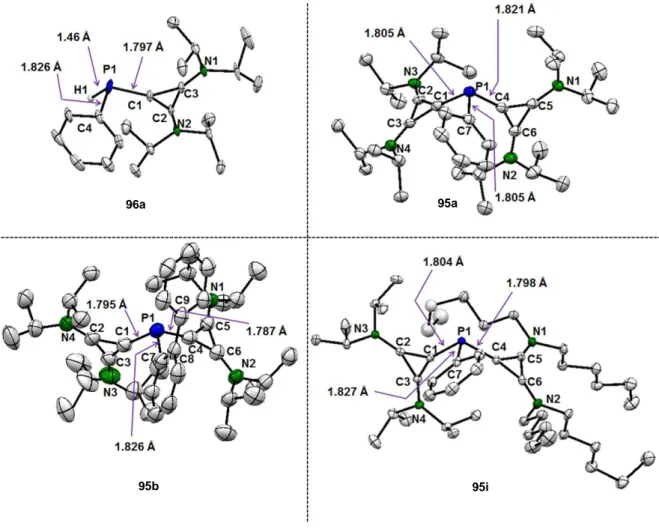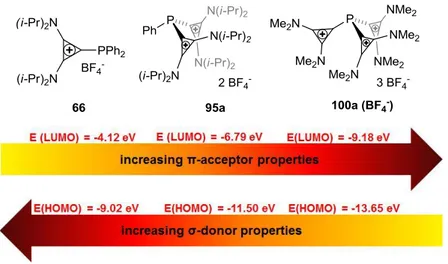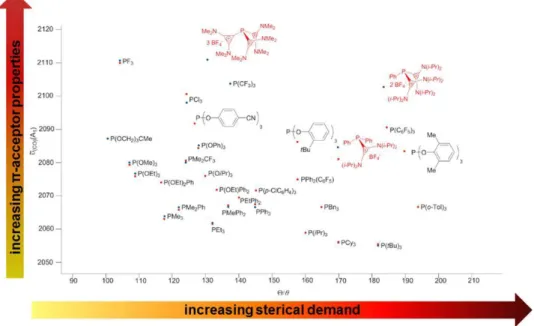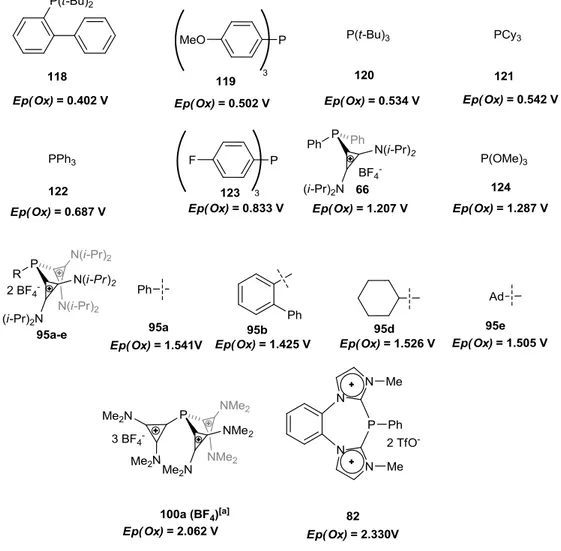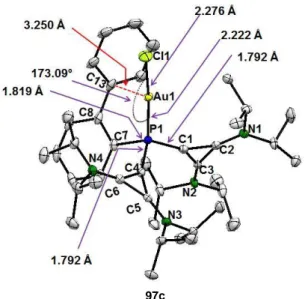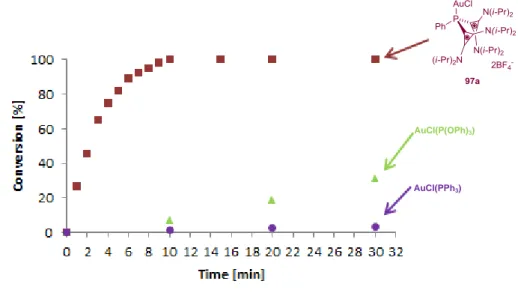phosphines as ancillary ligands in catalysis
Synthese und Anwendung von Biscyclopropenium Phosphinen als Liganden in der Katalyse
Dissertation
zur Erlangung des akademischen Grades eines Doktors der Naturwissenschaften
(Dr. rer. nat.) im Fach Chemie
durchgeführt am
„Max Planck Institut für Kohlenforschung“
in Mülheim an der Ruhr
im Zeitraum 1.07.2012-30.06.2015
im Arbeitskreis von Prof. Dr. M. Alcarazo
unter Aufsicht von
Prof. Dr. M. Alcarazo und Prof. Dr. A. Fürstner
vorgelegt von Dipl. Chem. P. M. Linowski
Hiermit versichere ich, dass ich die eingereichte Dissertation nur unter Mitwirkung der an gegebner Stelle erwähnten Personen verfasst und keine anderen als die angegebenen Quellen und Hilfsmittel benutzt, sowie Zitate kenntlich gemacht habe. Des Weiteren wird hiermit versichert, dass diese Dissertation (in dieser oder einer anderen Form) noch nie zuvor im Zusammenhang mit einer Prüfung bei einer Hochschule eingereicht wurde.
Datum:___________________ _________________________
(Unterschrift)
1. Berichterstatter: Prof. Dr. A. Fürstner 2. Berichterstatter: Prof. Dr. N. Krause
Die vorliegende Arbeit entstand auf Anregung und unter Anleitung von Herrn Prof. Dr. M.
Alcarazo am „Max-Planck-Institut für Kohlenforschung“ in Mülheim an der Ruhr in der Zeit vom Juli 2012 bis Juni 2015. Teile dieser Arbeit wurden im folgenden Artikel veröffentlicht:
Carreras, J; Gopakumar, G., Gimeno. A; Linowski, P.; Petuškova, J.; Thiel, W.; Alcarazo, M.;
J. Am. Chem. Soc. 2013, 135, 18815-18823.
Danksagung
Die vorliegende Arbeit zum Erlangen des Titels Dr. rer. nat. im Fach Chemie wurde im Zeitraum 01.07.2012-30.06.2015 am „Max Planck Institut für Kohleforschung“ in Mülheim an der Ruhr unter Anleitung von Prof. Dr. M. Alcarazo und unter Aufsicht von Prof. A.
Fürstner angefertigt.
An erster Stelle möchte ich Prof. Dr. M. Alcarazo für die Themenstellung und die große Hilfsbereitschaft während meiner gesamten Doktorarbeit danken.
Herrn Prof. Dr. A. Fürstner möchte ich sowohl für seine hilfreichen Vorschläge während der gemeinsamen Seminare als auch für die Übernahme des Erstgutachtens danken.
Herrn Prof. Dr. N. Krause gilt mein Dank für das Zweitgutachten.
Als nächstes möchte ich mich bei unserer technischen Angestellten Frau G. Mehler für das Bereitstellen diverser dikationischer Phosphine und der lipophilen Chlorcyclopropenium salze bedanken. Zudem bedanke ich mich bei Ihr für die Unterstützung bei der Herstellung dieser Verbindungen. Ohne sie wäre die Durchführung zügiger kinetischer Messungen schwieriger gewesen.
Außerdem gilt mein Dank insbesondere Dr. J. Carreras für seine Hilfe beim Einarbeiten in mein Themengebiet, seine Hilfe bei der Durchführung erster kinetischer Messungen und seine Mithilfe bei der Evaluierung der Cycloisomerisierung der Biphenyl-Alkine. Zudem möchte ich den Herrn Dr. J. Carreras und Dr. A. Zanardi für ihre Hilfe bei der Herstellung von Calanchinon C danken.
Bei Frau S. Holle (technische Angestellte) möchte ich mich für ihre Hilfe bei der Bewältigung praktischer Probleme im Labor bedanken.
Beim Arbeitskreis von Prof. Dr. M. Alcarazo möchte ich mich für die angenehme Arbeitsatmosphäre bedanken.
Mein Dank geht ebenfalls an die NMR-Abteilung unter Leitung von Dr. C. Farès, der X-Ray Abteilung unter Leitung von Prof. Dr. C. W. Lehmann und dem MS-Department unter der Leitung von Prof. Dr. W. Schrader für das zügige und verlässliche Bearbeiten der eingereichten Proben zu Analysezwecken. An dieser Stelle möchte ich ebenfalls Herrn C.
ihn wären zügige kinetische Messungen, die die GC-MS involvierten, nicht möglich gewesen.
Außerdem gebührt ihm ebenfalls Dank für die Durchführung der cyclovoltametrischen Messungen in userem Arbeitskreis.
Für die zügige chromatographische Reinigung von Substanzproben im semi-preparativen Maßstab möchte ich dem HPLC Department unter Leitung von Dr. P. Schulze danken.
Des Weiteren gilt mein Dank dem theoretischen Department unter Leitung von Prof. Dr. W.
Thiel für die Hilfe beim Klären mechnistischer Fragen.
Außerdem möchte ich mich bei Herrn M. Stesyecki für das zügige Beheben von Fehlermeldungen am Computer bedanken.
Für das Korrekturlesen meiner Arbeit bedanke ich mich bei Herrn Dr. J. Dube; Herrn Dr. J.
Peňa-González., Herrn M. Sc. L. D. Mwyena, Herr M. Sc. A. García-Barrado und Frau S.
Holle.
Den Herrn Dipl. Chem. E. Brüllingen und Dipl. Chem. Urlau-Clever danke ich für die finale Korrektur der Rechtschreibung und Grammatik.
Meinen Eltern und meiner Schwester gilt mein besonderer Dank für ihre moralische und praktische Unterstützung während meiner Doktorarbeit.
Inhaltsangabe
Die Entwicklung neuer Phosphane und ihre Anwendung in der Katalyse sind ein wichtiger Forschungsschwerpunkt in den letzten Jahrzehnten gewesen. Trotz der strukturellen Vielfalt der heutzutage bekannten und verfügbaren Phosphane kann man die meisten dieser Liganden im besten Falle als moderate π-Akkzeptoren klassifizieren. Solange solche elektronischen Eigenschaften für die jeweiligen Anwendungen ausreichend sind, sind mehr als genug Beispiele für (solche) P-zentrierte Verbindungen mit unterschiedlichen sterischen Eigenschaften, verfügbar.
Allerdings existieren einige katalytische Reaktionen, die die Gegenwart von Liganden mit sehr starkem π-Akkzeptor Charakter erfordern. In diesen Fällen gibt es nur wenige kommerziell verfügbare, neutrale P-zentrierte Liganden mit solchen Eigenschaften (PF3, P(CF3)3 und PCl3). Unglücklicherweise sind diese Verbindungen in der Regel toxisch und feuchtigkeitsempfindlich, was problematisch für ihre Anwendung in der Katalyse ist.
Aus diesem Grund bleibt die Entwicklung neuer π-Akkzeptor Liganden eine Herausforderung. In unserer Herangehensweise wurden zwei Cyclopropenium-Substituenten an das Phosphoratom des hergestellten Phosphins gebunden, um einen verstärkten π- Akkzeptor Charakter einzuführen. Diese synthetisierten Biscyclopropeniumphosphine waren luftstabil im Gegensatz zu ihren polyhalogenierten Analogen. Die Variation des dritten (nicht- kationischen) Substituenten, der an das Phosphoratom des dikationischen Phosphins gebunden ist, erlaubt die Modifikation der elektronischen Eigenschaften der jeweiligen Verbindung. Die Anbringung längerer aliphatischer Ketten an die Cyclopropeniumeinheit ermöglicht die vollständige Lösung des dikationischen Phosphins in nicht-polaren Lösungsmitteln wie Toluol. Außerdem wurde für einige der hergestellten Phosphine das BF4- Gegenion für SbF6- ausgetauscht, um später seinen Einfluss auf die Reakivität in der Katalyse zu untersuchen.
Die anschließende Koordinierung dieser dikationischen Phosphine an Übergangsmetalle resultierte in der Isolation der jeweiligen Au(I)-, Pt(II)-, Ir(I)- und Ag(I)- Komplexe.
Die Reaktivität der hergestellten Au(I)-präkatalysatoren wurde in der Cycloisomerisierung von Biphenyl-Alkinen mit zwei Substituenten in internen Postionen zu den jeweiligen Phenanthrenderivaten untersucht. Nach erfolgreicher Optimierung wurde diese Methodik in
Schließlich wurde der Anwendungsbereich der verwendeten Au(I)-präkatalysatoren von der Synthese von Phenanthrenderivaten zur Herstellung von Naphto-furanen erweitert.
Abstract
The development of new phosphines and their application in catalysis has been a major research topic during the last decades. Despite the structural variety of the known and available phosphines, nowadays, most of these ligands can be classified as moderate π- acceptors at best. As long as such electronic properties are sufficient for the derived applications, more than enough examples depicting different steric parameters are available.
However, some catalytic reactions require the presence of ancillary ligands with very strong π-acceptor character. In these cases only few commercially available neutral P-centered ligands exist (PF3, P(CF3)3 and PCl3). Unforunately, these compounds are usually both toxic and moisture sensitive, which represents a strong limitation for their application in catalysis.
Therefore, the design of new π‐acceptor ligands is still a challenge. In our approach two cyclopropenium substituents were attached to the phosphorus atom of the phosphine in order to introduce enhanced π-acceptor character. These biscyclopropenium phosphines, unlike their polyhalogenated analogues, were air stable. While the variation of the third (non- cationic) substituent attached to the phosphorus of the dicationic phosphine allowed further modification of its electronic properties, the decoration of one cyclopropenium unit with longer aliphatic chains facilitated the solution of the charged species in non-polar solvents like toluene. Furthermore, the BF4-
counter-ion of some of the prepared phosphines was exchanged for SbF6-
in order to investigate its influence on the reactivity in catalysis later on.
Subsequent coordination of these dicationic phosphines to various transition metals afforded the corresponding Au(I), Pt(II), Ir(I) and Ag(I) complexes.
The reactivity of the prepared dicationic Au(I)-precatalysts was investigated in the 6-endo-dig cycolisomerization of biphenyl-alkynes with two substituents in internal positions to their corresponding phenanthrene derivatives. After successful optimization, this methodology was applied in the synthesis Calanquinone C.
Finally, the substrate scope of the utilized Au(I)-precatalysts was expanded from the synthesis of phenanthrene derivatives to the preparation of naphto-furans.
Experience is the teacher of all things.
-Julius Caesar
1 Introduction ... 1
1.1 Phosphines with peripheral charges ... 4
1.2 Phosphines with charges directly attached to the P-center. ... 7
1.2.1 Introduction ... 7
1.2.1.1 Evaluation of electronic properties ... 10
1.2.2 Monocationic phosphines ... 12
1.2.2.1 Synthesis of monocationic phosphines ... 12
1.2.2.2 Applications of monocationic phosphines ... 15
1.3 Dicationic phosphines ... 17
1.4 Tricationic phosphines ... 20
2 Motivation ... 23
3 Synthesis and Evaluation of dicationic phosphines ... 25
3.1 Synthesis of dicationic phosphines ... 25
3.2 Structural properties of dicationic phosphines ... 29
3.3 Evaluation of π-acceptor properties ... 33
3.4 Evaluation of steric properties ... 34
3.5 Summary ... 37
4 Coordination chemistry ... 38
4.1 Coordination to Au(I) ... 38
4.2 Coordination to Pt(II) ... 42
4.3 Coordination to Ag(I) ... 43
4.4 Coordination to Cu(I) and Rh(I) ... 44
4.5 Coordination to Ir(I) ... 45
4.6 Summary ... 47
5 Applications in catalysis ... 48
5.1 Introduction ... 48
5.2 Synthesis of phenanthrene derivatives ... 49
5.2.2 Investigating the ligand effect ... 49
5.2.3 Investigating the substrate scope ... 50
5.2.4 Limitations ... 53
5.2.5 Exchanging the solvents ... 55
5.2.6 Theoretical studies on the catalytic system ... 56
5.2.7 Synthesis of Calanquinone C ... 58
5.2.7.1 Introduction ... 58
5.2.7.2 Optimization Studies ... 59
5.2.7.1 Synthesis ... 63
5.2.8 Summary ... 65
5.3 Synthesis of naphto-furans ... 66
5.3.1 Initial Evaluations ... 66
5.3.2 Ligand Effect ... 67
5.3.2.1 Comparison with commercial phosphines ... 67
5.3.2.2 Comparison with other dicationic phosphines ... 68
5.3.3 Substrate scope ... 69
5.3.4 Limitations ... 71
5.3.5 Summary ... 72
6 Experimental Part ... 73
6.1 General remarks ... 73
6.2 Analytical methods ... 74
6.3 Provided Chemicals ... 75
6.4 Literature known compounds ... 76
6.5 Synthesis ... 77
6.5.1 Synthesis of Cyclopropenium salts ... 77
6.5.2 Synthesis secondary phosphines bearing one cyclopropenium substituent ... 80
6.5.3 Synthesis of biscyclopropenium phosphines ... 84
6.5.4 Coordination chemistry of dicationic phosphines ... 90
6.5.4.1 Coordination to Au(I) ... 90
6.5.4.2 Coordination to Pt(II) ... 97
6.5.4.3 Coordination to Ag(I) ... 98
6.5.4.4 Coordination to Ir(I) ... 99
6.5.5 Preparation and cycloisomerization of biphenyl-alkynes ... 100
6.5.5.1 Synthesis of precursors ... 100
6.5.5.2 Synthesis of Biphenyl-carbaldehydes ... 101
6.5.5.3 Peparation of the corresponding alkynes ... 110
6.5.5.4 Cycloisomerization ... 118
6.5.5.5 Synthesis of Calanquinone C ... 128
6.5.6 Cycloisomerization of 2-(ethynylaryl)furans ... 133
6.5.6.1 Synthesis Carbaldehydes ... 133
6.5.6.2 Synthesis of the corresponding alkynes ... 138
6.5.6.3 Cycloisomerization ... 142
6.6 Computational Methods ... 147
6.6.1 General ... 147
6.6.2 Computational Results ... 148
7 Appendix ... 149
7.1 X-Ray ... 149
7.2 NMR-Spectra ... 161
8 References and endnotes ... 222
Abbreviations
Å Angstrom
Ac Acetyl
Ad Adamantyl
aq Aqueous
atm Pressure in atmospheres
[BMIM][BF4] 1-Butyl-3-methylimidazolium tetrafluoroborate
Bu Butyl
COD 1,5-Cyclooctadiene
Cpr Cyclopropenium
Cy Cyclohexyl
dba Dibenzylideneacetone
DCE 1,2-Dichloroethane
DCM Dichloromethane
dipp 2,6-Diisopropylphenyl
DMF Dimethylformamide
DFT Density functional theory
δ Chemical shift (NMR)
Ep(Ox) oxidation potential
Et Ethyl
equiv. Equivalent
EtOAc Ethyl acetate
GC-MS Gas chromatography – mass spectrometry
h Hour
Hex Hexyl
HOMO Highest occupied molecular orbital HPLC High-performance liquid chromatography HRMS High-resolution mass spectrometry
Hz Hertz
IR Infrared
J Coupling constant
KHMDS Potassium hexamethyldisilazane
L Generalized ligand
LnM Generalized metal fragment with n ligands
LDA Lithium diisopropylamide
LUMO Lowest unoccupied molecular orbital
m Meta
M Generalized metal
Me Methyl
MeO Methoxy
Mes Mesityl
min Minutes
MO Molecular orbital
MS Mass spectrometry
MTBE Methyl tert-butyl ether
n Normal
NHC N-Heterocyclic carbenes
NHP N-Heterocyclic phosphines
NMR Nuclear magnetic resonance
ῦ Frequency
o Ortho
p Para
Ph Phenyl
Pr Propyl
Py Pyridine
r.t. Room temperature
t Tertiary
Tf Triflate
THF Tetrahydrofurane
TLC Thin layer chromatography
TMS Trimethylsilyl
vs Versus
X Anion
1 Introduction
Phosphorus does not exist in nature in its elemental form as it is easily oxidized. It can be found in the earth crust in form of the salts derived from phosphoric acid, such as apatite (3 Ca3(PO4)2.
Ca(OH, F, Cl)2), or in the biosphere as derivatives of phosphoric esters and phosphates. Overall, its natural occurrence sums up to 0.1% (m/w%) of the total mass of the litho- and biosphere.[1] Elemental phosphorus is accessible in industrial scale by the reduction of the afore mentioned apatite with coke in the presence of silica at 1400-1500 °C in an arc furnace affording elemental P2, which dimerizes to P4 (white phosphorus) upon cooling.
Scheme 1-1: Reductions of phosphates to elemental phosphorus.
White phosphorus has a tetrahedral structure with P-P bond lengths in between 2.20 and 2.21 Å. It is extremely reactive, up to the point that it spontaneously ignites at room temperatures upon exposure to oxygen in a highly exothermic reaction.[1] Despite of that, white phosphorus is the key starting material for the preparation of bulk phosphorus chemicals like PCl3, PH3 and their commercial derivatives, which in turn, are used to access most of the known P-ligands in organometallic chemistry such as phosphines, phosphites and phosphoramidites.[1]
Phosphorus derived ligands have found a wide range of applications, in particular in coordination chemistry and catalysis. Examples for this privileged use as ligands can be found in many coupling (Scheme 1-2), [2,3,4] metathesis or hydrogenation reactions, among others.
Scheme 1-2: Suzuki-cross coupling in the presence of PPh3 as ligand. a) 0.1 equiv. mol% Pd(PPh3)4, 2 equiv.
NaOEt, benzene, 70 °C, 2 h.
For example, in order to improve all relevant reaction parameters of cross-couplings, such as selectivity, conversion-rate, functional group tolerance and catalyst loading, a lot of effort was
invested mainly into the design of new phosphorus based ligands modifying their structural and electronic properties. Thus, the evolution of P-based ligands in this area led to the synthesis of biphenylphosphines, which were first developed by S. L. Buchwald et al. for coupling reactions and later have been applied in a broad range of different reactions including Suzuki-Miyaura couplings (4 and 5),[5a, 5b] α-arylations of aldehydes (4 and 5),[5c]
Negishi-couplings (6),[5d] fluorination reactions (7),[5e] arylations of hindered primary amines (8),[5f] hydroxylations of aryl/hetereoaryl halides (9)[5g] and cyanation of aryl/heteroaryl halides (10, Figure 1-1).[5h]
Figure 1-1: Lewis-structures of biphenyl phosphines developed by S. L. Buchwald et al and John-Phos 11.
Despite of the fact that cross-couplings are one of the prominent fields for the application of phosphorus ligands like phosphines, there are many other catalytic reactions where such compounds are applied. John-Phos 11, one of the simplest Buchwald type phosphines, has been also successfully used in Au(I)-catalyzed processes. The cycloisomerization of enyne 12 to cyclobutene 13 reported by R. A. Widenhöfer et al. (Scheme 1-3) can be used as an illustrative example for this chemistry.[6]
Scheme 1-3: Au(I)-catalyzed cycloisomerization of enyne 12. a) 0.05 equiv. AuCl(11), 0.05 equiv. AgSbF6, DCM r.t..
Another interesting advantage of the utilization of phosphines as ancillary ligands derives from the relative facility to prepare chiral, enantiopure derivatives that expand the scope of their use to asymmetric synthesis. BINAP 14,[7] chiral phosphoramidite 15[8] and chiral
phosphine phosphite[9] such as 16 are excellent examples of chiral P-based ligands (Figure 1- 3), which have demonstrated extraordinary levels of enantioinduction in several interesting processes.
Figure 1-2: Examples for chiral P-centered pro-ligands.
BINAP 14 has been utilized with great success in the asymmetric Ru-catalyzed hydrogenation of α,β-unsaturated carboxylic acids,[7b] allylic alcohols,[7c] enamides[7d] and ketones [7e] by R.
Noyori et al. For example, the use of (R)-BINAP in the Ru(II)-catalyzed enantioselective hydrogenation of substituted enamides 17 provided the corresponding enantioenriched (protected) α-or β-amino acids 18 with up to 96% ee (Scheme 1-4).[7d]
.
Scheme 1-4: Noyori-reduction of enamides 17 to their respective α-or β-amino acids 18. a) 0.005 equiv.
Rh(OAc)2(14), H2 (1 atm), MeOH, r.t..
Additionally, chiral phosphoramidite 15 was used by B. L. Feringa et al. with great success, for example, as a ligand in the Cu(I)-catalyzed asymmetric 1,4-addition of Grignard reagents to allylic gem-dichlorides 19. The desired 1,4-addition products 20 were obtained in good yields (up to 74%), remarkable ees (up to 98%) and almost complete Z-selectivity (Scheme 1- 5).[8]
Scheme 1-5: Asymmetric 1,4-addition of Grignard reagents to allylic gem-dichlorides 19 by B. L. Feringa. a)
Another type of asymmetric reaction, which in this case was made possible by employing TADDOL-derived phosphine-phosphite ligand 16, is the enantioselective Rh(I)-catalyzed [4+2] cycloaddition of trienes of type 21. The enanatioenriched bicyclic products of type 22 were obtained in good yields (up to 83%) and up to 90% ee (Scheme 1-6).[9]
Scheme 1-6: [4+2] Cycloaddtion of trienes 21 to their respective bicyclic products 22 by H.-G. Schmalz et al.. a) 0.03 equiv. [RhCl(NBD)]2(NBD = norbornadiene), 0.06 equiv. AgSbF6, 0.072 equiv. 16, EtOAc, 50 °C
(microwave), 1-3 days.
While this is only a brief survey on the different P-centered ligands employed in catalysis, it clearly demonstrates the incredible power of ligand design. However, it has to be noted that most of the known P-based compounds, which were mentioned afore can be classified as poor-to-moderate π-acceptors and good-to-moderate σ-donors. As long as such electronic properties are sufficient, additional modification of the ligands remains unnecessary.
However, when strong π-acceptor properties become necessary to facilitate a certain reaction, only PCl3, PF3 and P(CF3)3 are readily available as these are the only phosphorus compounds possessing stronger π-acceptor properties than phosphites (e.g. P(OPh)3). These phosphines and their respective transition metal complexes are unfortunately highly air and moisture- sensitive, which makes them not the most adequate choices as ligands for catalysis.[10] For this reason, the development of new strategies to improve π-acceptor properties of the P-center of phosphines is still necessary.
1.1 Phosphines with peripheral charges
Homogenous transition-metal catalysis has grown in importance in both, academic and in industrial applications. Asymmetric hydrogenation, cross-couplings and hydroformylation are good examples for noteworthy applications with organophosphorus compounds playing a key role as ligands. However, the use of homogenous catalysts presents a challenge in their implementation on industrial scale. The separation of the catalyst from the product after the reaction is finished may not be straightforward. An elegant solution to this problem consists of the use water as a solvent for the reaction, if non-polar products are fromed that are easy to separate from this solvent due to their hydrophobic nature. In order to facilitate this separation even more, the catalyst should ideally remain in the aqueous phase after the reaction is
finished. A trick often used to increase the hydrophilicity of the catalyst consists of the introduction a positive or negative charge on the periphery of the ligand. This charge should be placed at a relative distance from the phosphorus to avoid changes on the electronic properties of the respective phosphine. Several phosphines containing positively charged moieties on their periphery have been developed with this objective in mind, and a selection of them is illustrated in Figure 1-3.[11]
Figure 1-3: Examples for phosphines possessing peripheral charges.
A good example for such a hydrophilic P-centered ligand with a peripheral positive charge is 1-Methyl-1,3,5-triaza-7-phosphaadamantan-1-ium iodide 23 (Figure 1-3), which was prepared by the methylation of the corresponding amine. By treatment of 23 with [(RhCl(CO)2]2 and [(Rh(I)(CO)2]2, complexes of type RhX(CO)L2 (X = Cl, I) were obtained and utilized in the hydroformylation of alkenes or in the reduction of aldehydes.[12]
Another example for such a charged phosphine is ben-Dendriphos 24 (Figure 1-3), which was used successfully by G. van Koten et al. in a Suzuki-Miyaura cross-coupling of various aryl bromides 27 with the corresponding boronic acids 28 in aqueous media, affording the coupling products 29 in moderate to good yields (57-99%, Scheme 1-7). A broad range of different functional groups (Scheme 1-7) is tolerated by this protocol, and the employed hexacationic ligand shows even higher reactivity than PPh3 under the evaluated conditions (aqueous media). Furthermore, it could be concluded that ben-Dendriphos 24 stabilizes the
ligand 24 favors the formation of a coordinatively unsaturated 16e--complex, which is probably facilitated by a combination of steric and Coulombic repulsions of the charged ammonium groups that avoids the coordination of a second phosphine to the metal center.[13]
Scheme 1-7: Suzuki-coupling in the presence of ben-Dendriphos 24 by G. van Koten et al. a) 0.01 equiv.
Pd(dba)2, 0.04 equiv. 24, MeOH/H2O, 65 °C.
Olefin metathesis has also benefitted from the use of cationic phosphines such as 25. In particular, this ligand has been useful in the evaluation of the ring-opening metathesis mechanism via ESI-MS spectrometry (Scheme 1-8). [14] The inactive precatalyst 30, the active monocationic species 31 as well as intermediates 32 and 33 were detectable in the MS- spectrometry utilizing this methodology.
Scheme 1-8: Intermediates 32 and 33 formed in the ring opening metathesis polymerization of cyclic alkenes in the gas-phase.
A very original additional application of the use of organophosphorus compounds with peripheral charges was recently reported by T. Ooi et al. (Scheme 1-9). He described a Pd(0)- catalyzed asymmetric allylation of α-nitrocarboxylate derivatives 34 with allyl carbonates 35 utilizing the ion-paired chiral ligand 26 (Figure 1-4 and Scheme 1-9).
The developed methodology delivered the enantio-enriched products 36 in excellent yields (up to 99%) and remarkable enantioselectivity of up to 97% ee. According to the authors, the Coulomb interactions between the charged phosphine and a chiral counter-anion, in this case binaphtolate, induce the observed enantioselectivity.[15]
Scheme 1-9: Pd(0)-catalyzed asymmetric allylation of α-nitrocarboxylate derivatives 34 with 2-en-1-yl derivatives 35 by T. Ooi. a) 0.0125 equiv. Pd2(dba)3, 0.05 equiv. 26, toluene/H2O, r.t.
The reaction itself follows a pattern similar to the Tsuji-Trost reaction as the initial steps is suggested to be the insertion of the [Pd(0)(26)2] species on the allylic carbonate resulting in the formation of π-allyl-Pd(II) complex. This structure would be maintained as the deprotonated nitro-ester is delivered via a hydrogen-bonding interaction to the phenolic proton of the binaphtolate anion. The organization of this intermediate through Coulombic interactions would be essential to produce the obtained enantioselectivity during addition of the pro-chiral nucleophile to the formed π-allyl-Pd(II) complex (Figure 1-4).[15]
Figure 1-4: Proposed catalytic cycle for enantioselective alkylation catalyzed by an ion-pair catalyst.
1.2 Phosphines with charges directly attached to the P-center.
1.2.1 Introduction
It was already mentioned in section 1.1, that the variety of neutral P-centered compounds,
phosphines. However, these halogenated compounds are usually labile, air/moisture-sensitive and therefore difficult to handle. An alternative approach to obtain the desired π-acceptor properties consists of the introduction of positively charged moieties in close proximity to the P-center. In contrast to compounds where the charge is attached on the periphery of the ligand, the new charges would not only result in a significant change of their solubility, but also in a modification of their electronic properties.
It is well known that in phosphines, the electron pair located on the P-center accounts for the σ-donor ability of the respective compound, while the σ*(P-C) orbitals govern its π-acceptor properties. A strong electron-withdrawing and positively charged group R’ attached to the P- atom, will decrease the energy of all molecular orbitals of the corresponding phosphine, including those responsible for its π-acceptor properties. For this reason, the resulting cationic phosphine should depict poorer electron donor and improved π-acceptor character when compared to their neutral counterparts.[16]
Figure 1-5: simplified molecular orbital diagram for PR3 diagram and the perturbation occasioned when one R group is substituted with one electron-withdrawing group R’.[16a, 16b]
Additionally, it has to be taken into consideration that most organic cationic substituents that can be introduced as electron-withdrawing groups R’ are aromatic rings, which already possess empty low lying π* orbitals. These π*-orbitals are also able to overlap with occupied orbitals on the P-center of suitable symmetry. Two of these secondary interactions are of high relevance for the evaluation of the electronic properties of the respective phosphines.
First, the orbital responsible for the σ-component of the P-M bond may delocalize electron density on the π-system of the aromatic ring, if the π system of the aromatic system is in plane with orbital containing the electron lone pair located on the P-center (Figure 1-6, A). As this interaction stabilizes the electron pair, it decreases the interaction with the orbitals of the metal. Due to this effect the σ-component of the P-M bond is weakened.
Second, an empty π-system which could interact with the orbital of 2a’’ symmetry of the phosphine, lowers the energy of that orbital additionally, as a consequence, it leads to an amplification of the π-acceptor properties of the respective ligand (Figure 1-6, B).[16a]
Figure 1-6: Secondary interactions A and B between phosphines and positively charged aromatic substituents,
The strength of both interactions depends on the relative energy level of the LUMO of the charged fragment as well as its orientation. As a result, different cationic substituents will have different effects. It can be concluded that the cationic substituent with the lowest LUMO should be able to maximize these secondary interactions and therefore, enhance the π-acceptor properties of the respective ligand significantly.
Our theoretical department calculated the LUMOs of the most common charged aromatic substituents at the B3LYP/6-31G* level (Figure 1-7). A comparison of the respective energy values, illustrates that the tropylium cation 37 possesses the lowest LUMO with -0.2817 eV while the cyclopropenium cation 38 possesses the highest one with -0.1388 eV. Therefore, phosphines with tropylium 37 as an electron-withdrawing substituent should possess the strongest π-acceptor properties and the weakest σ-donor abilities.[16a]
Figure 1-7: Calculated energy levels of the LUMOs of the most common cations, which can be used as substituents of phosphorus on theB3LYP/6-31G* level.[16a]
decreasing LUMO energy
Finally, there are two more factors, which have to be considered. First, the reduction of the σ- donation from the P atom to the metal due to the attachment of a positive charge is not completely compensated by the back-donation, resulting in a weaker M-P bond. This can lead to a complete disappearance of the coordinating properties of the ligand. Second, the presence of charged moieties on the coordinated ligand, results in Coulomb interactions between the respective ligand moieties and also between the ligand and the metal if both are charged. This will also drastically influence the stability of the complex.[16]
1.2.1.1 Evaluation of electronic properties
The traditional method to obtain information about the π-acceptor character of a ligand consists of the measurement of the carbonyl stretching frequency (ῦCO) of a metal-carbonyl complex, which is coordinated to the ligand under study. This is done normally using [Ni(CO)3L] complexes (Tolman method). Carbonyl ligands possess an empty, low lying π*- orbital (LUMO), which is capable of accepting electron density from an occupied metal d- orbital of suitable symmetry. If the phosphine coordinated to the same metal is a good σ‐
donor, the metal has more electron density to back‐donate into the aforementioned LUMO of the CO-ligand. As a consequence the carbonyl triple bond is weakened, resulting in a decreased wavenumber for the stretching frequency measured via infrared spectroscopy (Figure 1-8). The opposite can be observed, if the ligand under study is a good π-acceptor ligand. In such a case, back-donation from the filled metal d-orbital to the empty σ*(P-R)- orbital of the phosphine increases and, as a consequence, the metal has less electron density to share with the π*-orbital of the CO ligand. Due to this, the strength of the carbonyl triple bond does not diminish strongly and as a consequence the measured ῦCO value is similar to the one of free CO.
σ* (P-R) π*
Figure 1-8: Relevant orbital interactions between the CO and PR3 Ligands of a Ni(CO)3L
While it is also possible to use other metal fragments like [(L)Rh(Cl)(CO)2] or [(L)2Rh(Cl)CO] to determine this value, it must be considered that for complexes of type [(L)2Rh(Cl)CO] a tetrahedral distortion of the square-planar geometry is often observed, especially when bulky ligands are employed. This makes the comparison of ῦCO for the
different [(L)2Rh(Cl)CO] compounds increasingly difficult.[16b] As an alternative, the σ-donor properties of P-centered ligands can also be determined by the measurement of the oxidation potential Ep(Ox) by cyclic voltammetry. The electron richness on the P-center (where the ligand-HOMO is preferentially located) is inversely proportional to this value.[16b]
1.2.2 Monocationic phosphines
1.2.2.1 Synthesis of monocationic phosphines
Apart from the covalent description used up to now, most α-cationic phosphines can be additionally described as Lewis-acid-base adducts between a phosphenium cation and an appropriate Lewis base. The Lewis base can be another phosphine, a heteroaromatic ring or, as discussed in this thesis, a carbene (Figure 1-9). From this point of view, the synthetic approaches developed to prepare these compounds are obvious.
Figure 1-9: Up: Covalent model for phosphenium cation stabilized by a Lewis base as well the dative model.
Down Left: Preparation of phosphino-phosphenium compounds 48-49 and possible subsequent ligand exchange reactions. Down Right: Accessible products 48-51 through ligand-exchange.
Hence, N. Burford et al. developed a synthesis of phosphino-phosphenium compounds 48-49 starting with the abstraction of one chloride from a chlorophosphine 45, this leads to the in situ formation of a phosphenium cation 46, which was stabilized by the mesomeric delocalization of the positive charge, when aromatic groups like phenyls were attached to the P-center (Figure 1-9). Addition of an equivalent amount of a phosphine 47 leads to the formation of the corresponding Lewis-acid-base adduct 48-49 in good yield (77-88%), which
highlights the synthetic use of this procedure in the P-P bond formation.[17] Compounds 48-49 can be submitted to a subsequent ligand exchange using other ligands with better σ-donor properties (compounds 50-51, Figure 1-9). It has to be highlighted that it is possible to prepare the monocationic imidazolium phosphine 51 as well as the pyridine-phosphenium complex 50 following this route.[18]
Imidazolium phosphine 51 was prepared for the first time by N. Kuhn et al. in 1999, by a condensation of an N-heterocyclic carbene of type 52 (R1 = i-Pr, R2 = Me) with chlorodiphenylphosphine 45, affording the desired product 51 in very good yield (87%, Scheme 1-10).[19] The carbene itself was prepared from the corresponding thioureas in a two- step sequence.
While the protocol for the preparation of imidazolium phosphines 51 is quite reproducible, it requires careful handling of free carbenes, which are air sensitive species. In order to avoid this problem M. Azouri et al. devised an alternative route to access imidazolium phosphines of type 53a employing carboxylate derivative 54 as starting material (Scheme 1-10). In the presence of chlorodiphenylphosphine, 45 eliminates CO2 and the free carbene formed in situ reacts with chlorophosphines to afford imidazolium phosphine 53 in moderate to excellent yield after ion-exchange (58-91% yield).[20]
Another possible route to monocationic phosphines of type 53 involves the condensation of dihydroimidazolium chlorides 55b with the respective secondary phosphines (Scheme 1-10, route d). This methodology has been successfully applied in our work-group for the preparation of dihydroimidazolium 53b and formamidinium substituted phosphines.[21]
N. Kuhn et al. also managed to prepare the first transition metal complexes of these imidazolium phosphines in 1999 using PtCl2(MeCN)2 and PdCl2(MeCN)2 as a metal-sources, which gave the Pd(II)-complex 56 and Pt(II)-complex 57.[22]
Furthermore,the synthesis and coordination chemistry of dihydroimidazolium phosphines was also first described in our work-group. Coordination of Au(I) and Rh(I) to those α-cationic phosphines afforded Au(I)-complex 58 and Rh(I)-complex 59 (Scheme 1-10).[22]
The measurement of the CO-stretching frequency (ῦCO)of the Ni(CO)3L complex 60 provided a value of ῦCO =2082 cm-1, which classifies imidazolium phosphines of type 53a as moderate π-acceptors, similarly to phosphites, with ῦCO around 2085 cm-1.[16a]
Scheme 1-10: Left up: Possible pathways for the synthesis of diimidazolium phosphines 53a/53b. Left down:
Possible mechanism for the formation of imidazolium phosphine 53a from the carboxylate 54 upon addition of PPh2Cl according to M. Azouri et al.. Right: Metal complexes of diimidazolium phosphines 53a/53b. a) 1.0 equiv. PPh2Cl, Et2O, r.t, 1 h .; b) 1.0 equiv. PPh2Cl, DCM, r.t., 4 h; c) 1.25 equiv. KPF6, acetone, r.t., 2 days; d)
2.0 equiv. R32PH, THF, reflux, 24 h.
Our work-group has also recently developed two additional families of monocationic phosphines with intersting π-acceptor properties: cyclopropenium phosphines of type 61[23]
and pyridinium phosphines of type 62[24] (Scheme 1-11), both prepared by condensation of the corresponding chloro cyclopropenium 63[25] or chloro pyridinium salt 64 respectively, with secondary phosphines (Scheme 1-11). The pyridinium phosphines 62 showed stronger π- acceptor and weaker σ-donor character as deduced from the carbonyl-stretching frequencies (ῦCO) of the corresponding Ni(CO)3L complexes and the oxidation potentials Ep(Ox ) of the free ligands (66 and 67):
ῦCO (Ni(CO)3(67)) = 2094 cm-1> ῦCO (Ni(CO)3(66)) = 2082;
Ep(Ox, 67) = 1.398 V >Ep(Ox, 66) = 1.207 V.
The increase of the π-acceptor properties of the pyridinium phosphines 62 compared to the cyclopropenium phosphines 61 was expected since the LUMO of the pyrdinium moiety lies much lower in energy than the LUMO of the cyclopropenium ring.
Scheme 1-11: Left up: Synthesis of chloro cyclopropenium salt 63 by Weiss et al. Right up: Synthesis of chloro pyridnium salts 64 by M. Alcarazo et al. Middle down: Synthesis of cyclopropenium phosphines 61/
pyridinium phosphines 62 by M. Alcarazo et al. Right: Examples for both ligand types. a) 4 equiv. (i-Pr)2NH, DCM, r.t., overnight; b) 1.0 equiv. R13OBF4, DCM, r.t. c) 2.0 equiv. H-PR22, 1.0 equiv. 63/64, THF, reflux, 24-
72 h.
Figure 1-10:Transition metal complexes prepared from monocationic phosphines 67 and 68.
Phosphines 61 and 62 were successfully coordinated to Pt(II), Au(I), Rh(I) and Cu(I) (only 61), affording the corresponding metal complexes 68-71 (Figure 1-10).[26, 27] The chemistry and applications of monocyclopropenium phosphines is described in detail in the Ph.D. theses of J. Petšukova and Á. Kozma and only a short summary is given here.
1.2.2.2 Applications of monocationic phosphines
A good example for the application of imidazolium phosphines like 72 as ligands in catalysis is the Pd-catalyzed Negishi cross-coupling reaction developed by P. Knochel et al. The reacction tolerates a broad range of different functional groups (R1 = COOMe, OMe, OTIPS, Cl, CN, thiophene-ZnBr, (C6H5)-CH2-ZnBr; R2 = COOEt, NO2, OAc, OMe). Furthermore, the utilization of a ([bdmim][BF4])/toluene solvent mixture allowed an easy separation of the synthesized biphenyls 73 from the catalyst, thus allowing the re-use of the catalyst in further catalytic cycles (Scheme 1-12).[28]
Scheme 1-12: Negishi cross-coupling in an ionic liquid utilizing ligand 72. a) 0.02 equiv. Pd(dba)2, 0.04 equiv.
72; toluene/[bdmim][BF4], r.t..
A second application reported by X. Li et al. describes the Rh(I)-catalyzed hydrosilation of alkenes. The authors demonstrated that [RhCl(76)3] (Scheme 1-13) show a significantly higher activity and β-selectivity in the hydrosilation of terminal alkenes 77 ([bmim][PF6] as a solvent) than RhCl(PPh3)3. TONs of up to 20000 were measured. It is suggested in their publication that the close proximity of the positive charge to the P-atom greatly enhances the catalytic activity. Moreover, it was possible to re-use the ionic liquid containing the Rh(I)- catalyst for at least four cycles without a significant drop in activity.[29]
Scheme 1-13: Rh(I)-catalyzed Hydrosilation of Alkenes in ([bmim][PF6]) utilizing ligand 76 by X. Li et al.
a) 0.00005-0.0002 equiv. Rh(I)(76)3Cl, ([bmim][PF6]), 70 °C.
1.3 Dicationic phosphines
The list of dicationic phosphines that are known in literature is significantly shorter than that of the monocationic analogues. One example is bisimidazolium phosphine 81, which was prepared from carboxylate 54 using the same protocol, which was employed for the synthesis of the monocationic analogues 53a. In this case two equivalents of 54 and only one of dichlorophenylphosphine afforded the desired dicationic phosphine 81 in very good yield (81%; Scheme 1-14; for the mechanism Scheme 1-10).[30]
Another bisimidazolium phosphine, which is accessible from dichlorophenylphosphine, is compound 82. This phosphine was prepared by R. Chauvin et al. from 1,2-di(1H-imidazol-1- yl)benzene 83 in a three step sequence (Scheme 1-14), which includes deprotonation of the bisimidazol species, followed by a condensation with dichlorophenylphosphine, and selective methylation at both N-atoms.[31] While the calculated carbonyl stretching frequency ῦCO
= 2115 cm-1 of compound 81 implies that it is an extreme π-acceptor ligand, the measured oxidation potential Ep(Ox) = 2.330 V of compound 82 shows that bisimidazolium phosphines should be extremely poor σ-donors. Due to this, it is not surprising that no metal complex derivatives from 81 and 82 are known.[16,30,31]
Scheme 1-14: Up: Synthesis of diimidazoliumphosphine 81 by M. Azouri et al.. Down: Synthesis of diimidazoliumphosphines 82 by R. Chauvin et al. a) 0.5 equiv. PPhCl2, DCM, r.t. 18 h; b) 2.5 equiv. KPF6, EtOH, 24 h; c) 2.0 equiv. n-BuLi, THF, -78 °C, -78 °C to r.t., r.t., 4 h; d) 0.5 equiv. PPhCl2, THF, - 78 °C, -78 °C
to 60 °C, 60 °C, 2 h; e) 2.0 equiv. MeOTf, DCM, r.t.
Dicationic chlorobisimidazoliumphosphine salt 85 has been prepared by a protocol published by J. J. Weigand et al. The key step in this reaction was the nucleophilic substitution of two chlorides in trichlorophosphine by the silyl protected carbene 86. Depending on the stoichiometry, either dichloroimidazoliumphosphine 87 or chlorodiimidazoliumphosphine 85
were accessible in quantitative yields (85: 99%; 87: 98%; Scheme 1-15). These compounds could be used as [PCl2]+ and [PCl]2+ synthons, in fact, it was possible to exchange the chloride substituent by either CN- or N3- groups.[32] Silyl imidazolium 86 itself was prepared by silylation of the free carbene. It has to be highlighted that the utilization of silyl protected carbenes was essential to obtain compounds 85/87 without undesired side reactions. It is known that the treatment of trichlorophosphine with NHC 51 results in the formation of 88 and 89 through a redox process besides the expected condensation (Scheme 1-15).
Scheme 1-15: Up: Synthesis dichloroimidazoliumphosphine 87 or chlorodiimidazoliumphosphine 85 by J. J.
Weigand et al. Down: Possible side reaction in the condensation of carbene 51 and PCl3. a) 1.5 equiv. PCl3, fluorobenzene, 50 °C, ultrasound bath, 10 h; b) 2.0 equiv. PCl3, fluorobenzene, 50 °C, ultrasound bath, 24 h.
The first and only dicationic phosphine capable of coordinating transition metals prior to this work was prepared by M. P. Coles et al. from the bicyclic guanidine 90 in a two-step sequence (Scheme 1-16). First, 1,3,4,6,7,8-hexa-hydro-2H-pyrimido[1,2-a]pyrimidine 90 was submitted to deprotonation generating an amide, which reacted with DCM to yield the CH2 bridged species 91. Secondly, the condensation of 91 with chlorodiphenylphospane afforded the desired dionium-phosphine 92. Interestingly, it was possible to treat this charged phosphine 92 with [PtCl2(PEt3)-µ-(Cl)]2 to form the Pt(II)-complex 93, which upon heating to 50 C,exchanged the PEt3 ligand by one of the Cl- counter ions affording the desired complex 94. A structural confirmation of the constitution of the free phosphine 92, as well as Pt-complex 94, was achieved via XRD-analysis.[33]
Scheme 1-16: Up: Synthesis of dionio-substituted phosphines 92 by M. P. Coles et al. Down: Formation of corresponding Pt-complexes 93 and 94. a) 1.1 equiv. NaH, 0.5 equiv. DCM, THF, r.t.; b) 1.0 equiv. Ph2P-CL, DCM c) 1.0 equiv. [PtCl2(PEt3)-µ-(Cl)]2, DCM, r.t.; d) 50 °C, 24h (yields were not described by the authors for steps b-d).
Finally, another example of a dicationic phosphine capable of coordinating transition metals was prepared by J. Petuškova in our work-group. A cyclopropenium unit was utilized as a positively charged moiety in these compounds. Biscyclopropenium phosphine 95a was accessed in moderate yield (Scheme 1-17) over two steps from the chloro cyclopropenium salt 63.[34] The synthetic sequence included a condensation with a primary phosphine to first yield monocationic phosphine 96a. Subsequent deprotonation with a strong base afforded a phosphaalkene, which was then reacted in situ with a second equivalent of the chloro cyclopropenium salt 63. Interestingly, it was possible to coordinate phosphine 95a to Au(I), Pt(II) and Pd(II), resulting in the formation of complexes 97-99 (Scheme 1-17).
The use of these dicationic phosphines as ancillary ligands in catalysis is the main topic of this thesis. Therefore, their stereoelectronic attributes will be evaluated in more detail in the discussion part of this work.
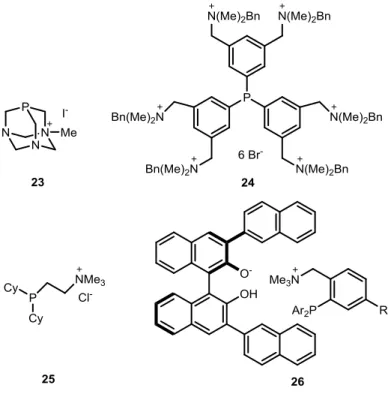
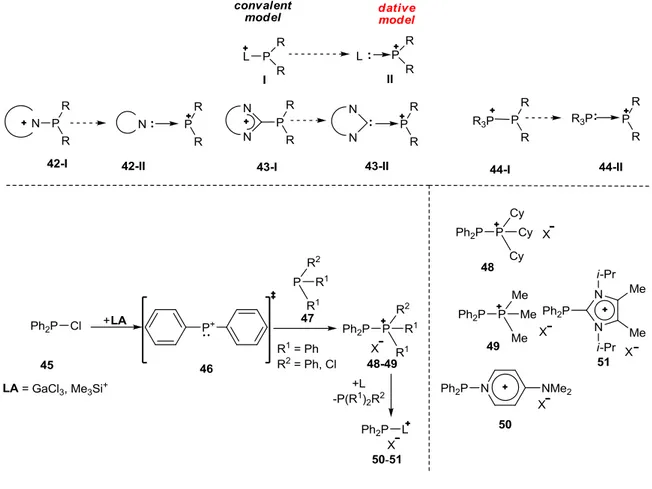
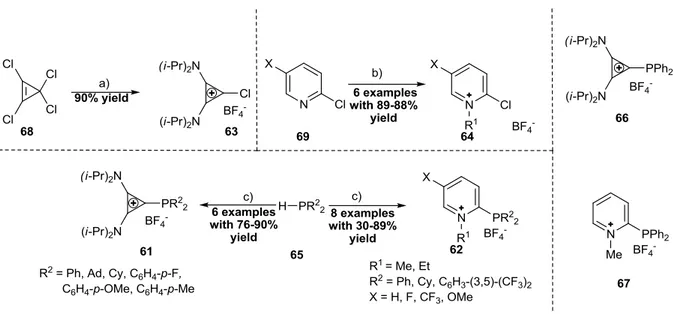
![Figure 1-11: Ligand effect on the cycloisomerization of binaphtyl alkyne 104a. [36]](https://thumb-eu.123doks.com/thumbv2/1library_info/3631910.1502250/44.892.207.812.90.502/figure-ligand-effect-cycloisomerization-binaphtyl-alkyne-a.webp)
